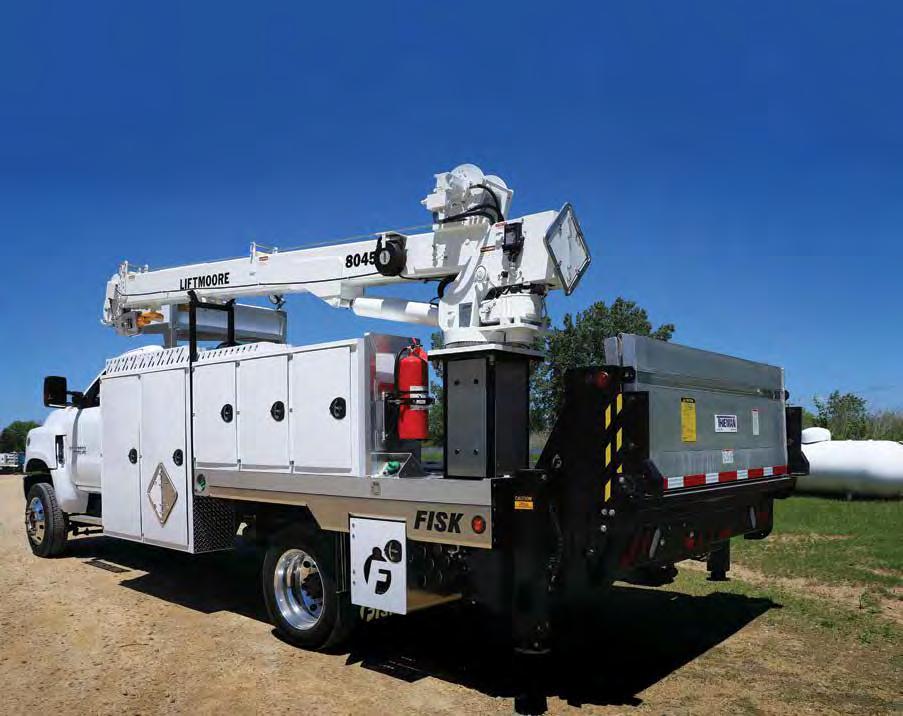










This month’s feature article goes in depth on Duty to Warn. The article delves into the history, the importance for your company, and how to utilize ProCOT’s Duty to Warn program. It is easy, eco nomical, and has a robust mailer that can be sent out to all your customers. Be sure that you are taking care of this important step for your company. Your insurance company will appreciate it also.
As for the upcoming winter prediction, there is a split decision from the triedand-true forecasters (The Old Farmer’s Almanac, The Farmer’s Almanac and NOAA). The Almanacs target January 2023 to be the stormiest for Texas where
heavy snow is predicted during the first week. NOAA is predicting that North Texas and the Panhandle will have average temperatures for the winter and other parts of Texas to be above average. Their maps show lower than expected precipitation for all of Texas. I guess we will have to wait and see!
Also included in this issue are some great employee prep courses from PERC to prepare for winter. These classes are on demand and self-paced, online training covering topics like customer service representative, driver, service and installation and cylinder fillers.
The fall board and related committee meetings is coming up later this month. I hope to see y’all there.
President: Allen Wells, Wells Propane, 281-332-2630
President Elect: Larry Baty, Cadenhead Servis Gas, 800-722-8654
Secretary: Harris Baker, HBH Systems, 512-587-8347
Treasurer/Finance Chair: Jeremy Gentile, Hill Butane, 409-296-2001
District 1 Director: David Collett, Gas and Supply, 903-780-2488
District 1 Alternate: Open
District 2 Director: Matt Brock, McAdams Propane, 936-598-7444
District 2 Alternate: Open
District 3 Director: Open
District 3 Alternate: Open
District 4 Director: Danny Meyers, Bellville Butane 979-865-2698
District 4 Alternate: Matt Peterson, Buster Brown Propane, 281-689-3946
District 5 Director: Ryan Tudyk, Howdy Propane Services, 361-771-1900
District 5 Alternate: Open
District 6 Director: Omar Garcia, Mr. G Propane, 956-581-1063
District 6 Alternate: Alex Hinojosa, Hino Gas Sales, 956-423-9178
District 7 Director: Sharon Seal, Bell Hydrogas, 210-533-7103
District 7 Alternate: Open
District 8 Director: Rodney Sladek, Fayetteville Propane, 979-836-7044
District 8 Alternate: Open
District 9 Director: Brad Quisenberry, Gene Harris Petroleum, 817-295-1091
District 9 Alternate: Larry Hearn, Yellow Rose Propane, 870-648-8241
District 10 Director: Josh Nowlin, McCraw Propane, 9003-583-7481
District 10 Alternate: Chad Gregg, Enderby Gas, 940-482-3225
District 11 Director: Steve Adams, Hardwick LPG, 254-647-3402
District 11 Alternate: Open
District 12 Director: Laci Jo Stone, Schneider Distributing, 800-901-9109
District 12 Alternate: Open
District 13 Director: Lane Worthington, WTG Fuels, 432-682-4349
District 13 Alternate: Casey King, WTG Fuels, 432-894-4240
District 14 Director: Terry Perez, Perez Propane, 512-318-9780

District 14 Alternate: Open
District 15 Director: Don Heinrich, Slaton Gas, 806-828-6501
District 15 Alternate: Open
District 16 Director: Mark Garrison, Fred Garrison Oil, 806-296-6353
District 16 Alternate: Open
Past President: Josh McAdams, McAdams Propane, 936-598-7444
Past President: Mark Peterson, Buster Brown Propane, 281-689-3946
Past President: Jack Walzel, Tri-Co Propane, 254-642-3885
Past President: John Walter, Schneider Distributing, 800-901-9109
Past President: Ben Wood, Northwest Propane, 972-247-6121
Vice President: Steve Adams, Hardwick LPG, 254-647-3402
Vice President: Jeremy Gentile, Hill Butane, 409-296-2001
Vice President: Matt Terry, Matador Gas, 210-560-5418
Sr. Vice President: Todd Dorris, Roadrunner Energy, 830-278-2915

Sr. Vice President: Bill Collins, Collins Propane, 972-442-1078

Sr. Vice President: Joe Green, Green’s Blue Flame Gas, 713-462-5414
Assoc. Supplier Service Director: Kirk McGarrah, Cox2M, 713-897-1740
Assoc. Supplier Service Alternate: Open Assoc. Producer/Marketing Gas Director: Jimmie Grant, Martin Gas Sales, 713-851-6155
Assoc. Producer/Marketing Gas Alternate: Jim Fulton, 4J Energy, 281-728-8567
Assoc. Manufacturer/Distributor Director: Tracy Wells, Gas Equipment Co, 214-683-8018
Assoc. Manufacturer/Distributor Alternate: Joe Ezernack, Meeder Equipment, 903-877-9401
Assoc. At Large Director: John Becraft, Targa Resources, 817-416-7757
Assoc. At Large Alternate: Crystelle Markley, Superior Energy Systems, 512-944-4177
Nominating Chair: Ben Wood, Northwest Propane, 972-247-6121
NPGA Director: Chad Gray, Dixie LP Gas, 254-582-5359

 By Kimberly Scheberle
By Kimberly Scheberle
Here’s the thing. Every propane marketer knows about Duty to Warn. Yet, if you ask them the origin of the obligation to warn or educate their customers, they would not be able to point you in a concrete direction. They would not be able to show you in statute or law or regulation what their actual obligation is, save for a provision in the LP Gas Safety Rules to provide Texas consumers a Consumer Safety Notification.

That’s because there is no hard and fast law. Duty to Warn was born mainly as a defense mechanism against litigation. But even though its origins are in the courtroom, educating propane consumers is good policy.
The concept of “Duty to Warn” is not propane specific. Several big court cases from the 1970s are often sited as the beginning of Duty to Warn.
In one, the California Supreme Court held that a mental health professional had a “duty to protect” an individual who was being threatened harm by a patient. The original suit followed the tragic story of two students who met at UC Berkeley in 1968. Prosenjit Poddar came to believe that he was in a serious relationship with Tatiana Tarasoff, a view that was not shared by Tarasoff. When she told him that she was not interested in a romantic relation ship, he began to stalk her and had a serious breakdown. Poddar became a patient of a UC Berkeley psychologist, who held the opinion that he posed a danger to himself and should be hospitalized. The psychologist did not warn Tatiana Tarasoff. Poddar murdered Tarasoff, and her family sued the university for its failure to protect her.
There have been court findings throughout the years in many fields that mirror this duty to warn or protect a consumer or in dividual.
Attorney David Schlee, a longtime defense counsel who has been involved in more than 1,000 gas-related lawsuits, claims and investigations since 1987, says that when he started in the mid- to late 1980s, the claims that garnered the most traction centered around odor fade.
“So you would have an explosion and somebody would say ‘I didn’t smell gas,’” Schlee said.
“There got to be a real scientific battle over whether this chemical phenomenon, which is really pretty rare, happened.”
“There was enough science to the possibility of odorant loss that the plaintiff’s lawyers, very cleverly, said, well this is a big conspiracy that the gas companies are trying to hide this from you,” Schlee said. “That’s where a lot of this re ally got started.”
Lawsuits against the gas suppliers would go up the food chain. They would name all of the entities: the pipeline, the distributor, the wholesaler and the propane manufacturer. Big settlements were made.
Schlee says these verdicts encouraged all of the people up the chain from the retailer to tell the person next down the line to pass it down to the customer. Which of course, ends at the propane marketer.
“Before the odorant issue came up, during the 1970s and 1980s, the warnings were very rudimentary,” Schlee said.
It was during this time period that Phillips Petroleum/Phillips 66 developed a brochure that warned about odorant fade, along with other propane safety information. It was widely used.
In the early 2000s, the Propane Education and Research Council (PERC) developed its own brochure. It is a very detailed asset that’s been vetted by legal and technical experts and is cur rently in use today, be it an updated version.

Schlee says that if he were a marketer, he would use the PERC or ProCOT brochures or something equivalent.
“If you provide warnings, then that’s your defense [against duty to warn lawsuits]," Schlee said. “It neutralizes that claim. If you do nothing, you will be vulnerable. It’s potentially easy to make that claim if you don’t do anything.”
That said, nothing is a guarantee.
“I can’t stop someone from suing you; I can’t stop someone from making a Duty to Warn claim. You get to a jury and they have their own discretion and are influenced by a lot of factors.”
But Schlee reiterates, “Juries are very accepting of the PERC brochure when presented it.”
Richard Gilbert, a longtime Texas propane professional in a va riety of roles and former TPGA President, recommends using the published material developed by PERC, which is what ProCOT uses as well. Gilbert took over Gilbert Gas Co., his father’s business, in 1973 and “retired” from that career after 30 years. He went on to work for the Texas Railroad Commission in the LP Gas Compliance division, and currently is a technical advisor for TPGA, in addition to offering expert testimony in court cases that involve gas.
“I think the industry just assumes that the customer knows what to do,” Gilbert said. “And I think that’s a dangerous assumption.” In addition to the vetted brochure, Gilbert feels that the
First Contact Information and CSR training should be central to a marketer's Duty to Warn program. “Each of those programs triggers a series of questions that everyone in your organization should be able to answer the same way.”
“It is assumed and presumed that we have a greater knowledge of the hazards of the product than the average consumer. And because of that greater knowledge, we have a duty to warn them about certain aspects.”
Gilbert recommends marketers create a Duty to Warn program that includes every employee.
“Develop a duty to warn program that is based off either an industry standard like ProCOT or PERC,” Gilbert said. “Develop it across your entire company.”
“You may have three people who work for you—someone is going to answer the phone, someone is going to deliver the gas, someone is going to work on the water heater. They all deal with the consumer in different ways. But they all should be coordinated in saying the same message and staying on message.”
Additionally, Gilbert emphasized the importance of repetitiveness. “It has to be reinforced and be repetitive. It has to be intro duced in more than one way. They need to read it, hear it, see it.”
“It doesn’t have to be a pamphlet or a flyer. It can be a calendar. As long as you get the information out and repeat it and repeat it and repeat it.”
Schlee says the documentation component is important as well. “Keep the mailing, keep the mailing list, keep the mailing records,” Schlee said. “Defense counsel has to prove to a jury what was sent and that it was sent.”
Schlee added that the more often you send out safety materials, the better you are. Once is different than once a year. The more often, the better off you’ll be.
Gilbert said that whatever your warnings are to your consumer, make sure your employees know what the warnings are and follow them themselves. For instance, if a customer calls in and says they smell gas, do you recommend they vacate the building and call you back? Or do you advise them to vacate and call the fire department? Or do you give them a choice on whom to call? “Everyone in your company needs to have the same message. It shouldn’t be different messages.”
Gilbert also feels strongly that marketers should sit down with their insurance carriers, who are not opponents, but partners.
“When you have an incident, that insurance carrier is either going to be your best friend or your worst enemy. Contact that carrier and say ‘take a look at what I’m doing and tell me if I need be doing something else.’”
For the past 15 years, the Propane Council of Texas (ProCOT) has provided a cost-effective way to help propane marketers meet their duty to warn requirements to their customers.

“What we do is provide that comprehensive safety material, and we make it available through a safety mailing program that we started in 2007,” said Jackie Mason, ProCOT Director.
The ProCOT brochure takes the vetted PERC brochure and adds a Consumer Safety Notification that the Texas Railroad Commission requires.
LP Gas Safety Rule §9.32 states: person holding a license to install or repair an LP-gas system who sells, installs, or repairs an LPgas system, piping, or other equipment that is part of a system, or an appliance that is connected or attached to a system shall provide the following notice to the purchase or owner of the system, piping, or other equipment or appliance: “WARNING: Flammable Gas. The installation, modification, or repair of an LPG system by a person who is not licensed or registered to install, modify, or repair an LPG system may cause injury, harm, or loss. Contact a person licensed or registered to install, modify, or repair an LPG system. A person licensed to install or repair an LPG system may not be liable for dam ages caused by the modification of an LPG system by an unlicensed person except as otherwise provided by applicable law.
The rule goes on to say: A person holding a license to install or repair an LP-gas system who sells, installs, or repairs an LP-gas system, piping, or other equipment that is part of a system, or an appliance that is connected or attached to a system shall document the notice requirements.
ProCOT’s Duty to Warn Safety Mailing Program is one way to document this requirement and get other comprehensive valuable safety information to their customers.
While there’s no firm interpretation on how many times a
Texas consumer must receive that notification in the life of their contract, more can never hurt in terms of Duty to Warn.
“The big part that we hear is documentation, documentation, documentation,” Mason said. “Not only do we [ProCOT] cover the cost of the postage and mailing the brochures, we also provide the documentation.”
“They receive a notarized affidavit that it went out on a certain date along with a detailed postage statement. They have that pack age they can keep in their records.”
“We advocate to not just rely on one source for safety information. We encourage people to provide safety information to their customers in various other ways, be it through messages on the back of meter tickets or invoices. There are a lot of different vehicles to get out safety messages.”
ProCOT’s Duty to Warn mailer is one of the organization’s most sought after and utilized programs. Application for this year’s program started in early September and closes December 2. They expect to mail around 250,000 brochures this year.
“For those who participated last year, ProCOT will be sending Duty to Warn anniversary reminders. The program is first come first served while supplies last or until December 2, whichever comes first.”
ProCOT also provides a lot of good safety material in its annual Propane Safety Tip & Recipe wall calendar, which is additionally offered to marketers to send to their customers.

ProCOT just wrapped up 2023 calendar orders and they will ship later this month to participants. The calendar covers a lot of the core propane safety messages like: what to do if you smell gas, interruption of service, the importance of not running out of gas, and maintaining appliances.
For those wanting to find something even more robust or compre hensive information for new customers, PERC has released the newly redesigned and updated Propane Safety Booklet. The booklet covers such topics as uncapped lines, steps to take if you smell gas, propane gas detectors, carbon monoxide safety, appliance safety and main tenance tips, flammable vapor ignition, weather-related emergencies, and small cylinder safety. The brochure includes a scratchand-sniff test just like the PERC & ProCOT Important Infor mation For You & Your Family Brochures. The booklet is sold in packs of 25 or as a package in Propane Service Corporation’s New Customer Packets.
While Duty to Warn ma terials through PERC and ProCOT were developed in the wake of litigation, educating consumers about the potential hazards of propane should always be an impor tant pillar of a propane mar keters’ business.
“There is a presumption that most people should know that a hazardous material has hazards,” Gilbert said. “And yet, I’ve seen a lawsuit where a consumer said that the pro pane company never said that propane would burn.”
“As an industry we have a requirement to tell people that it does burn. If it is released, it can accumulate. And that there is an artificial odorant added to it.”
Safe consumers made good customers.

What
peratures
for a location
a standard temperature, usually 65° Fahrenheit (F) in the United States. The more extreme the outside temperature, the higher the number of degree days.
People like the propane industry study degree day patterns to assess the climate and to assess the heating and cooling needs for different regions of the country during the seasons of the year.


Newspapers may publish degree day information in the weather section. Elec tric and gas utilities may publish degree
information on their websites, and some utilities include degree day data in customer utility bills.
Several weather data-related websites

Propane Plus, LLC 450 County Road 180 Leander, TX 78641
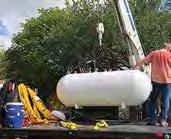

https://propaneplusatx.com propaneplus01@yahoo.com 512-259-7587
Propane Plus, LLC 5325 W. Highway 29 Bertram, TX 78605


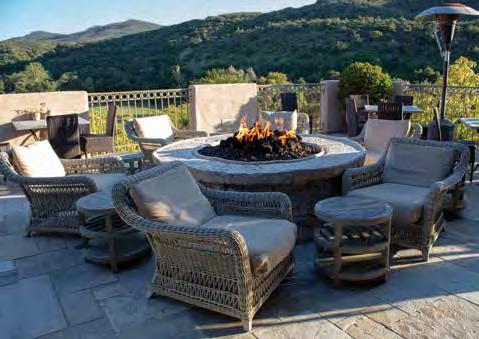
The surge in fire pits for outdoor liv ing projects that took place during the pandemic comes as little surprise. With many guests unable or unwilling to gather inside, businesses expanded their operations outdoors to stay afloat.
What’s perhaps more surprising is that fire feature manufacturers and distribu tors are still tracking sales significantly above pre-COVID numbers, indicating a sustained interest among designers and businesses in enhancing outdoor living
spaces, said Casey Harvey, vice president of sales for propane gas equipment and appliance distributor Ray Murray.
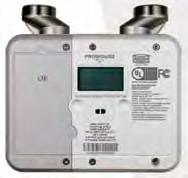

By adding light and warmth to gather ing spaces, fire pits represent an affordable opportunity to make an outdoor space valuable year-round, said Art Kunkle, vice president of sales for fire pit manufacturer Warming Trends.
“I think what we’ve seen is a main streaming of the outdoor space and folks realizing that they don’t have to spend a hundred thousand dollars,” Harvey said.
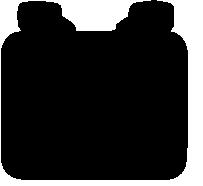
“You could spend $5,000 or $10,000 and get a beautiful, usable outdoor space. So I think the mainstreaming of that trend is here, and I think we’ve hit a new plateau in order to enable growth going forward.”
Here are six trends driving the sustained growth of commercial fire features.
1. Fire pits are a cost-effective option to make an outdoor space stand out.
In a world where adding hardscape, paving, and retaining walls can send the costs of a project soaring, fire features represent an affordable opportunity for a designer or contractor to make an outdoor space valuable throughout the year, says Art Kunkle, vice president of sales for fire feature manufacturer Warming Trends. “A fire feature gives them a reason to be out of doors,” he says. “It’s a source of light. It’s a source of warmth. It’s a great place for people to gather. That makes their project a year-round return on investment instead of just seven months of the year.”
2. Hospitality and multifamily projects lead the way.
Restaurants, hotels, and resorts have always been prime candidates for outdoor enhancements, and Harvey has even seen major hotel chains adding outdoor kitch ens with fire features. Apartment complexes and even senior centers are also using fire pits as a hook to draw people outside to enjoy the building’s common
areas. Harvey has also seen rising inter est from new restaurants in using large fire pits as a design feature at the entrance, rather than just as a gathering space.
3. Regional design trends take over stone.
While stone has traditionally been the material of choice for fire pit surrounds, designers today are willing to experiment with other materials that follow regional trends, Harvey says. In the Northeast and along the East Coast, for example, metallic and modern finishes that resemble a kitchen design have become more popular.
4. Linear fire features carve out a larger role.
Round fire features still make up the majority of installations, with larger round shapes measuring 6–8 feet in diameter becoming increasingly common, Harvey says. But long, narrow, linear fireplaces are also growing in popularity. “We’re starting to see the division of this outdoor room into specific zones for different things, and using these long, skinny fireplaces or fire pits is a nice way to break up the space,” he says.
5.Propane- and gas-fueled features provide safety and convenience.
Several factors are driving a move to propane or gas fire features from wood, Kunkle says. A number of state and lo cal ordinances prohibit burning wood in general or during periods of stagnant weather conditions to limit wood smoke and particulate pollution. Floating embers from wood can also pose a wildfire risk in some areas. Propane fire features include a thermocouple safety feature that closes the gas valve if the fire is extinguished by wind or rain. They also don’t leave guests with a campfire smell on their clothes or require owners to chop or store firewood.
6.Built-in gas lines offer operational advantages.
For most commercial businesses, running dedicated gas lines to the fire pit is preferable to a standalone propane tank, Harvey says. Rather than requiring staff to switch out cylinders in the middle of a meal service and having servers deal with relighting the flame, a dedicated gas line can be hidden away or run underground and connected to a facility’s main propane storage. Alongside the fire pit, businesses and designers can include gas grills and
outdoor heaters with better performance than electric alternatives.

Even buildings with existing fire pits are now making the upgrade to gas, Har vey says. “The prices have been reasonable
for gas fire pit inserts,” he says. “It’s prob ably anywhere from $200 on the low end to $2,000 on the high end for the burner and the controls, and then you’ve got to run the gas line. So it’s not a major retrofit installation cost.”
For an amenity that can keep an out door space habitable, cozy, and easy to maintain year-round, it’s an investment many businesses will find worthwhile.
This article is courtesy of the Propane Edu cation & Research Council and is reprinted with permission.
1) Some have grown frustrated with the lack of timely response and personal service from their current agent.
2) Many have discovered a missing piece of coverage after meeting with us.
3) Most tell us they have no idea what companies insure their industry and are surprised to learn there are multiple options available.
“I cannot say enough about Rusty and his team at Marshall Young Insurance. Not only are their prices highly competitive and comprehensive, but their customer service is outstanding as well. Marshall Young’s team goes above and beyond to exceed our insurance needs.”


Other propane owners have come to our agency to get help with connecting their insurance pieces:
• Uncontrolled Release of Propane
• Conducting a Customer Site Assessment
• Transport Operator
• Fundamentals of Liquid Transfer
• Hazardous Materials Training (2022)
• Entry Level Driver Training
• Safe Driving
• Inspect Commercial Motor Vehicles
• Cylinder Delivery Driver
Service & Installation
The Propane Education
Council (PERC)
an
New Employees/Employees with No
• Conducting a Customer Site Assessment
employ ees or give
essentials
help
the busy
• Introduction to the Propane Industry

•
of Propane
•
•
of Propane
•
Bobtail Rollover
•
• Gas Check
• Regulator Operation
• Measuring Pressure
• Testing Gas Piping
• Uncontrolled Release of Propane
• Restoring Service After an Interruption of Service
• Lighting Appliance Pilots
• Mobile Crane Safety
• Cathodic Protection
• Dispensing Propane Safely
• Cylinder Requalification
• Static Electricity
• Hazardous Materials Training (2022)
• Consumer Safety
• Propane Personal Safety & Injury Prevention

Go to https://training.propane.com/ Employees can register and get a username and password. Each employee should have their own login so it can track all the courses they take. A transcript is available to download of all the coursework completely.
Login and click on Safety & Technical to take any of the above classes.








"In marketing our company for sale, I could not have chosen a better team than Chad and Tyler Pendill, of Legacy Energy Consulting. After our first consultation, I immediately felt I was in the hands of an industry professional, as well as a friend. His advice and guidance throughout the entire process was spot on, as well as their constant communication. Chad’s guidance from the very beginning, right through to the end, was amazing.




Length: 2–5 minutes
Read the background information. Review and bring the company’s policy on backing and spotters for reference.
According to the National Highway Transportation Safety Administration, about 210 fatalities occur every year when a vehicle backs over a person. The use of safe backing vehicle tips, as well as tech nology and effective use of spotters, can help prevent crashes while on the job.
Play the following video from OSHA: https://www.osha.gov/vtools/construction/
What are some effective ways technol ogy is helping drivers avoid the dangers of backing over?
Cameras: OSHA states that most vehicles can accommodate a camera to provide drivers with a view of the rear and other
blind spots. When equipping vehicles with cameras, it is important to consider the worksite environment.

Some constructions sites and mines may require more rugged cameras, and vehicles such as dump trucks may need two or more cameras to monitor blind spots.
Proximity detection systems: These systems use radar and ultrasonic technology to bounce a signal off an object. The system then alerts the vehicle operator with a visual or audio warning that an object is in its way. However, these systems are only useful when they can be heard and when used with an Internal Traffic Control Plan.
Spotters also play a key role in ensuring safe communications on a worksite.
What is a spotter, and what are some do’s and don’ts for using one safely?
• A spotter is another person who can help a driver with backing.
• The driver and the spotter should use hand signals instead of verbal ones and make sure they understand each other’s signals.
• Ensure spotters always have visual contact with the driver when a vehicle is in motion. If the driver loses sight of the spotter, he/she should stop moving the vehicle immediately.
• A spotter should never be walking backwards while giving instructions.
• A spotter should not be given additional duties while spotting.
• A spotter should not be using a mo bile device or headphones while spotting.
• Spotters should be provided highvisibility clothing.
Internal traffic control plan: Create a plan to coordinate the flow of moving equipment, workers, and vehicles to help minimize the number of times workers and vehicles cross paths. According to OSHA, these plans can significantly reduce and even eliminate the need for vehicles to back up on a jobsite.
If your company already has an internal traffic control plan, that’s great! Allow for extra time to review it with your drivers. Ask for their input, and discuss any recent events or examples that might include the use of your company’s internal traffic control plan.
When backing, you want to use all systems available—mirrors, cameras, sensors, and spotters. But you don’t want to become too reliable on one over the other.
Spotters are a great tool for avoiding backing over objects or people, but only when used carefully. Drivers and spotters need to plan ahead, figure out the best way to communicate, and make that communication the top priority when the vehicle is in motion.
Information is compliments of the National Safety Council in partnership with the Texas Department of Transportation. For more information and traffic huddles, visit www.txdrivingconcern.org.





















For 231 years, The Old Farmer’s Alma nac has been providing weather forecasts. For the upcoming 2022-2023 winter, the editors of the book predict “A Tale of Two Winters” because the weather this winter will split the country in two. One region will be very cold, the other will be mild.
“Depending on where you live, this will be the best of winters or memorable for all the wrong reasons,” reports Janice Stillman, editor of The Old Farmer’s Almanac. “One half of the country will deal with bone-chilling cold and loads of snow, while the other half may feel like winter
never really arrives.”
Texas, you guessed it, falls into the “very cold” category. While November 2022 and December 2022 feature predictions of 3 degrees above average and 2 degrees above average, respectively, the deck is shuffled at the new year. They predict that for the Texas/Oklahoma region January will be 7 degrees below average and Feb ruary will be 4-8 degrees below average, before moving to above average in March (and staying there).

Precipitation for winter will be below average, but snowfall will be above aver-


age in the north, with the best chances for snow in mid- to late January and early February.
What’s shaping the weather, according to the Old Farmer's Almanac? “Recent Solar Cycle 24 had the lowest level of solar activity in more than 100 years. We are now early in Cycle 25, which is expected to peak around July 2025 and also bring diminished activity, which historically has meant cooler temperatures, on average, across Earth.”
The Farmers’ Almanac (not to be con-
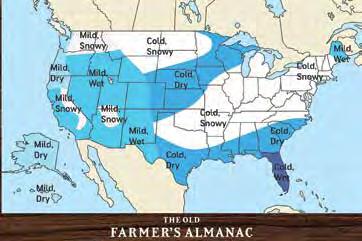
fused with the Old Farmer’s
has been providing extended weather forecasts since 1818, as well.


It predicts shivery temperatures will rattle warm weather seekers in the South east and South Central states, but the real shivers might send people in the Great Lakes areas, Northeast, and North Central regions hibernating. According to the Farmers’ Almanac, the North Central States are forecast to experience extremely cold temperatures, (possibly 40° below zero!) especially during mid-January.
Areas in the western half of the coun try should escape major shivers, with an overall forecast of brisk temperatures predicted in the Northwest and mild temperatures in the Southwest.
The Farmers’ Almanac suggests a stormy winter is on schedule especially for the


eastern half of the country. For some areas this may mean snow, but for others it will result in more slush and mush.
January 2023 looks to be the stormiest for many areas including Texas and Oklahoma, where heavy snow is predicted during the first week. Unfortunately, a dry winter is predicted for the Southwest states, which won’t help the drought situation.
The National Oceanic and Atmospheric Administration (NOAA) issues its full winter weather predictions in mid- to late October. However, they have issued maps that show general temperature and precipitation expectations for the fall. Those charts show that they expect North Texas and the Panhandle to be about average temperature for the winter and other parts of Texas to be above average. Their
map shows lower than expected precipitation for all of Texas.
For those keeping track at home, the three entities predict precipitation in the winter months to be: dry, normal and dry. And for the temperatures to be: colder, colder and normal to above average.
In the short term, NOAA predicts that most all of the lower 48 states will see temperatures above average in October, with about half of the lower 48, including Texas, seeing less precipitation than normal.
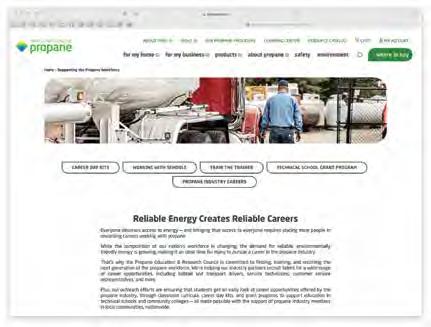
other industries face and who we’re in direct competition with for the same limited labor pool,” says Bridget Kidd, PERC’s senior vice president of industry relations.
“That’s the thing we have been trying to identify as a propane industry: How do we differentiate ourselves from other industries and attract job seekers that are qualified and will make good, solid em ployees for the industry?”
PERC and the National Propane Gas Association have been working together since 2018 to develop programs and resources that industry members can use to attract and retain workers. That includes partnering with groups like the National Association of Workforce Boards, the Association for Career & Technical Education and The Office of Apprenticeship within the U.S. Department of Labor.
For generations, the propane indus try has been marked by one truism: our people are our backbone. They starkly dis tinguish us from each of our sterile public utility competitors.
Their personal touch puts a familiar face and voice to the reliable, affordable energy that allows customers to live how and where they want. They are the fathers, the mothers, the family members, and the work colleagues who share a proud sense of community that propane customers value.
But the painful truth is that most pro pane employees are industry veterans who are moving on to a well-earned retire ment. Industry surveys continue to pound a clear refrain that companies are struggling to find and retain good employees.
The dearth of drivers and service technicians is not just a propane problem. The 2020 pandemic lockdown aggravated a nationwide worker shortage – particularly in field operations positions.
“We’re fighting the same issues that many
With surging U.S. job growth in July pushing the nationwide level of employ ment above its pre-pandemic level, Kidd believes the industry can find timely traction in its united message to the next generation of job seekers.
Whether they are students thinking about what field they want to enter, or entry-level applicants planning their next career move, many of today’s job seekers are interested in working in an environmentally conscious industry. That aligns well with propane’s role in reducing carbon and greenhouse gas emissions now and in the future.
“The fact is, demand for reliable, envi ronmentally friendly energy keeps grow ing. That makes it an ideal time for many to pursue a career in the propane industry,” Kidd says.
Resources are available to help propane companies find, train and retain the next generation of bobtail and transport driv ers, service technicians, customer service representatives and more.
Marketers are encouraged to reach out to local secondary educational facilities, technical and trade schools, and commu nity colleges where they can find people who are seeking education and training, and ultimately a career.
Find the tools and resources you need to bolster your team roster at https://propane. com/supporting-the-propane-workforce/.




Joe Byron Cobler, 90, of Euless, TX, passed away on August 31, 2022. Growing up he worked alongside his father on their farm, and he also worked in his father’s business making propane tanks, with his father teaching him the art of welding. He later studied electrical engineering at Arlington State College. In 1952 he joined the Marines and was assigned to the 7th Engineer Support Battalion in Camp Pendleton. After returning home, Joe worked for a few years at Trinity Industries in Fort Worth as a welder. He later worked as a service contractor and was a stocking distributor for W & T. He never retired. Our thoughts and prayers go out to the family at this time.


Longtime propane industry innovator Jim Coker passed away on August 13, 2022, shortly after being diagnosed with APL Leukemia. Jim has served as President of Onyx Environmental Solutions, which patented the first commercial propane mower. Jim then went on to work for Metrolawn, a division of Heritage, and AmeriGas Propane continuing to promote the propane mower market. Most recently, Jim was the Director of Propane Applications at Propane Power Systems that produced small engine propane conversion systems and made significant headway in the propane concrete trowel market. Our thoughts and prayers are with his family.

Robert Chen has been named Lock America’s new National Sales Manager. Robert succeeds Dan Walsh on Dan’s retirement. Lock America develops, manufactures and markets a wide range of security locks and hardware for many markets, including Amusement and Vending, ATM, Information Management, Municipal Government, Petroleum and Propane Distribution, and Self-Storage. Congratulations!
A partnership with Emily allows the message of propane buses to extend to her social media audience and educate more people about the benefits of clean, reliable and affordable propane buses.
Follow The Space Gal on any social platform and be sure to share her content on your own social channels for your cus tomers and potential customers to see.
business and network of MAKEEN Gas Equipment. GEC continues to thrive on the tenets that Milt laid out in 1937.
Known as “The Space Gal,” Emily Calandrelli, MIT graduate and Emmynominated host of ‘Emily’s Wonder Lab’ on Netflix, spoke with 45 TV and radio outlets nationwide about propane school buses.

As part of PERC’s annual Back to School communications program, Emily shared the science about propane buses so parents, school transportation directors and administrators can make informed choices about buses that produce fewer emissions for ultimately cleaner air.
In 1937, Milt LaDue founded Gas Equipment Company (GEC) in Dallas, Texas. Celebrating their 85th anniversary, GEC is an integrated warehouse distributor of in-process, transfer and control equipment for gas producers, transporters and LP gas marketers. GEC was the first RegO LPG equipment distributor and is the old est LPG equipment distributor for the mar keter segment of the LP gas industry.
In March of 2020, GEC was acquired by MAKEEN Energy. The acquisition was aimed at strengthening the global


January 1, 1972, Jan Peterson’s moth er, Lois E. Brown, incorporated and ran Buster Brown Propane from her dining room table. One truck and one driver. They now have nine drivers and two service teams. Fifty years, third generation and still going strong!
Crum & Forster was founded in 1822 as The North River Insurance Company in New York by Captain Richard Whiley. That founding kicked off two centuries and counting of helping customers manage their coverage needs.
“Throughout its long history, from the 1800s and later owned by Xerox, to being both a public company and now one that is privately held under the parent company Fairfax Financial Holdings, Crum & Forster has provided clients with a wide range of insurance products and solu tions, either directly or through our diver sified distribution network of brokers and producers,” the company says.
C&F believes in “doing good by doing well.” It is committed to supporting the
communities where its employees live and work and it has programs aimed at driving positive change among the diverse groups it serves through both charitable giving and community service and engagement.
In 2023, Crum & Forster will be cel ebrating another milestone for provid ing insurance products for the propane industry for a solid straight 100 years. Crum and Forster has been a solid partner in the propane industry for 100 years and looks forward to the next 100 years.
PERC’s Technical School Grant Pro gram offers funds to educational institutions (technical schools, community colleges, etc.) to give their students a hands-on learning experience – and more career opportunities after graduation –with a propane specific curriculum and the chance to outfit your classroom lab with propane related equipment.
The Testing Gas Piping education program is now available for FREE on demand to take in the PERC Propane Online Learning Center. An instructor led format is also available.
This program was developed to ensure customer safety by making sure custom er’s propane piping doesn’t leak. Its goal is to educate learners on how to test gas piping to verify its mechanical integrity and to check for leaks.
There are seven modules in this program:
• Pressure Testing
to
•
• Leak
• Leak
• Leak
• Leak
•
Take the training FREE now at https:// training.propane.com/.

Don’t forget grant applications are open through the end of November for technical schools interested in upgrading or expanding school labs to teach specific propane curriculum.

Reach out to schools in your area and encourage them to apply.
Learn more & apply at https://propane. com/supporting-the-propane-workforce/tech nical-school-grant-program/.

For National Fireplace Month, the Hearth Patio & Barbecue Association (HPBA) is conducting a national media relations and social media campaign called “House-Warming,” reminding homeowners that a fireplace truly is the best gift they can give themselves when building, buying or renovating.
“House-Warming” will inform consumers of the multiple reasons why a fireplace, stove, or woodburning heating product should be top of the list when building or updating a home – from being a reliable heating source during unexpected climate events, to serving as a secure sanctuary.

•TCEQ Seaport and Rail Yard Areas Emissions Reduction Program OPEN

Deadline November 22, 2022
and
be sharing grant
mag azine
and close.
(at time of printing):
•TCEQ Texas Natural Gas Vehicle Grant
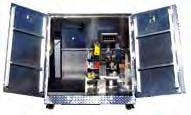


(TNGVGP) OPENING
•TCEQ
Program -
•TCEQ Statewide Light-Duty Motor Vehicle Purchase Program OPEN







Deadline January 7, 2023
Have questions on grants but do not know what grant is right for you or your fleet customers? Contact the Propane Council of Texas (ProCOT) at info@ propanecounciloftexas.org or call us at (800)325-7427.









Texas Propane is the official publication of the Texas Propane Gas Association and is the only publication geared exclusively toward the Texas propane industry. Each month, the print and online edition of Texas Propane reach over 1,000 decision making propane industryprofessionals (including every licensed full-service Texas propane retailer) providing an effective platform to market your products.

Print and online edition are distributed to over 12,000 propane



professionals annually.

Alliance AutoGas 19
Propane
Bergquist
BLT Tanks 5
Ferrellgas
Fisk Tank Carrier Inc.
Equipment Company 19 Insurors of Texas 16
Legacy Energy Consulting 17

Lock America 26
Lone Star Energy Group 27
Longhorn Propane 11
Lumbermen’s Insurance Agency 12

Marshall Young Insurance 15
Meeder Equipment Co. 27
Propane Plus LLC 13
Propane Service Corporation 25
Computer Consultants 21 Tarantin Industries 26 White River Distributors
Ever thought you looked into a fire and felt like the flames were dancing to the music? Well, it’s not just the alcohol speaking!
Ukiah Co., a Pacific Northwest entity founded in 2018, is on a mission to offer new unique products to the outdoor living market.
Their products feature something they call “Beat to Music” mode, which synchronizes flame to music with their “Reactive Flame Technology”. Dancing flames harmonize with music for amplified entertainment.
The Tailgater II is one of their more recent product introductions, and it is their most versatile fire pit available. The portable fire pit offers Bluetooth pairing and upgraded audio system with two 3.5 inch speakers and one subwoofer. There are four modes offered for the pit: Music, fire, fire and music, and Beat to Music.
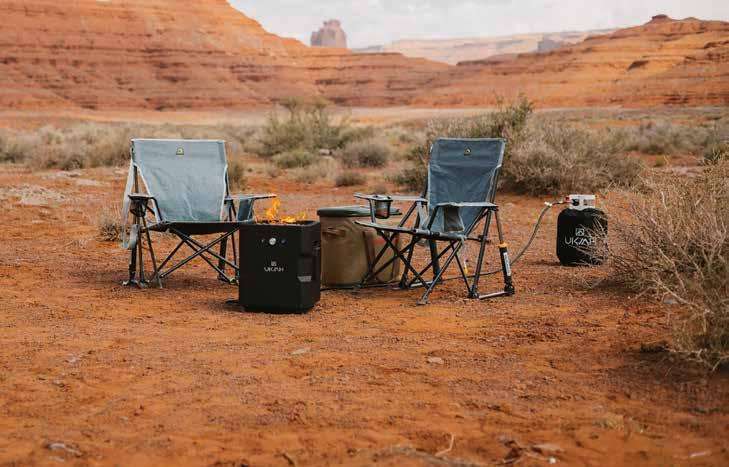
It features a re-chargeable battery or a connection to a 20 pound propane tank, which lasts 10+ hours with the fire pit on high.

They additionally offer a table-top fire pit with the Beat to Music sound system called the Loom II. Select “Music Only” mode and play your favorite music, podcast, or audio book. Efficient custom
made li-ion battery ensures long operation times and flexibility of use whether on the deck, patio or in the backyard.
For more information, visit https://www.ukiahco.com/.
When the weather turns cold, the opportunities for your business heat up. Now’s the time to start showing your customers all the ways you can help keep them warm and comfortable throughout the season. From making plans for winter deliveries to offering solutions such as fireplace installations and generators, you can position your company for better sales and stronger relationships.
Download your winter preparedness resources propane.com/preparing-customers-for-winter





